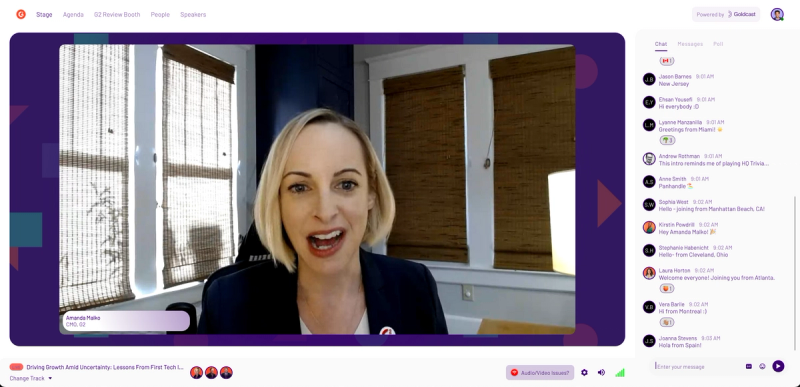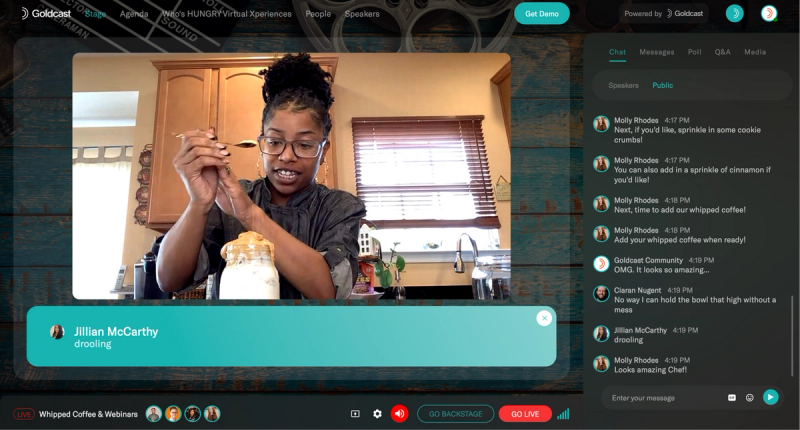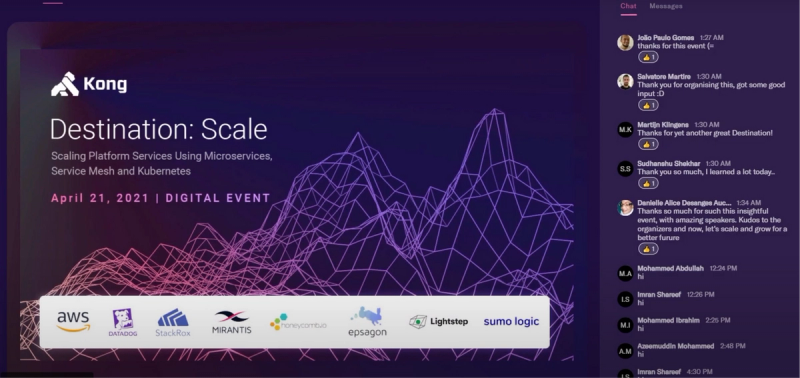Customer Marketing Meets Events: 7 Types of Events to Engage and Delight Your Customers

Maximize Your Marketing ROI
Join 10,000 other marketers already getting the best tips on running engaging events that boost pipeline and create raving fans.
Customer marketing is all about deepening your customer relationships to increase loyalty, product adoption, and upselling opportunities. It’s about creating experiences for your customers that go beyond user support. To build connections and communities that turn customers into brand champions.
Easy, right?
Not really. Fortunately, we had the chance to sit down with two amazing customer marketers, Katlin Hess of G2 and Leslie Barrett of Sendoso, during our Rock Your Funnel session diving deep into all things customer marketing.
Check out the session below to hear them talk all things customer events, community-building, and “doing more with less” (pro tip: please don’t say this to customer marketers 🫠).
For fresh ideas for ways to use your events to engage your customers, read on.
Digital vs. in-person customer events: The pros and cons
First the elephant in the room. What’s more effective for customer marketing: in-person events or digital?
It’s the age-old answer — it depends. Both event formats can create an excellent experience for your customers when done well. Let’s take a closer look at some of the pros and cons of each.
Benefits of digital customer events:
- More affordable: In-person events can be expensive for both organizers and attendees.
- Wider reach: A physical event location hinders accessibility to attendees who lack the budget to travel.
- More convenient: Your customers have jobs and lives. Even if they live in your city, a digital event is much easier for busy professionals with packed schedules. In fact, convenience is the number one reason attendees like digital events.
- Easier content access: In-person events have a fixed schedule and attendees have to choose between sessions. Virtual event attendees often have access to recorded sessions afterward.
- Fewer health and safety risks: Many attendees are conscious of the risks associated with large in-person gatherings.
Areas where in-person events shine:
- Natural networking opportunities: 67% of attendees like the social aspect of events, and it can be easier for attendees to mingle and chat in person.
- More immersive experience: It’s harder to achieve a high level of engagement with digital events, since attendees can become distracted more easily.
- Fewer technical issues: Tech can still cause hiccups at in-person events, but depending on the event platform you choose, they may be less common than with digital events.
At the end of the day, there is value in both customer event formats. It all comes down to your goals. Do you want to build hype around an annual, in-person event? Or will you see better results from regularly engaging your customers with convenient, digital events?
Today, some of the best customer marketing strategies do both.
And it’s a good thing, too, because attendee preferences are leaning toward digital. Our recent attendee survey found that 81% are more willing to sign up for hybrid and virtual events compared to in-person.
The good news is, event marketing technology has come a long way in the past few years and digital event experiences are now more dynamic and interactive than ever.
7 types of versatile and engaging customer events
In the same survey, 72% of respondents said having the right technology is what makes a virtual event excellent.
The tech you use for your digital customer marketing events is the number one factor that can make or break the experience for your attendees. Here at Goldcast, we thrive on helping our clients overcome the challenges that make customer events anything less than seamless.
Here are seven of our favorite types of customer marketing events to help you take engagement to the next level.
1. User conferences
An exclusive event for your users — whether in-person, digital, or hybrid — user conferences help customers take product adoption to the next level.
By helping your customers get the most out of your product, you show them you’re invested in their success long after the sale — building affinity, creating brand advocates, and increasing retention with every session.
Of course, this event is also a golden opportunity to showcase your other products and services, which can also help you expand existing contracts.
To make this happen, you need an agenda jam-packed with engaging sessions. Keep attendees entertained by filling five-minute time gaps with short videos promoting your company and your partners.
You can also create buzz by including some ‘just-for-fun’ non-traditional sessions. For example, our friends at Smartling treated attendees of their Global Ready Conference to a live performance by The California Honeydrops. In the middle of a pandemic, they pulled off a virtual event that blew their goals out of the water, bringing in 1,400+ registrations with a 42% live attendance rate.
“We didn’t just want to give people a high-quality event,” says Smartling former Head of Marketing Adrian Cohn. “The goal was for them to watch the event and say, ‘Holy smokes, this is what Smartling is capable of doing.’”
📈 KPIs to watch: Renewals, expansions
2. Product launch and education
After months of developing a new product, it’s pretty exciting to hit the big green “Live” button. And what better way to drive instant adoption than with a product launch event for your existing customers and power users?
With a well-planned product launch event, you can give your current user base an exclusive look at your latest and greatest features. It’s also a great opportunity to teach them how the new feature works in tandem with their existing favorites to help make life easier.
What’s on the agenda at a high-impact virtual launch event? Your attendees want to see the product in action, but don’t stop the storytelling there.
Spend some time at the beginning of your event illustrating the problem your new product solves. Why did you develop it? Why now? This will help your customers identify their own use cases and build more excitement to start using your latest offering.

During our Rock Your Funnel session, Leslie Barret, director of customer marketing at Sendoso, shared how she makes launch parties an exciting to-do for her customer advocate group.
“The schtick of our advocacy program is that you get to see what’s coming out before anyone else — and even before Sendoso employees,” she reveals. “It’s all about making them feel really special.”
Leslie explains how revealing new products and features early to this group benefits the product team: “Our advocates, they’re no joke. They are in this platform religiously and they ask extremely deep, hard questions to our product team on that call.”
📈 KPIs to watch: Adoption, pipeline, revenue (renewals and expansions)
3. Customer masterclasses
When you have a customer base that uses your product a lot, masterclasses just make sense. These highly-engaging webinars help your customers learn how to use your tools better and get more value out of your products.
G2 includes masterclasses as part of their annual Reach digital conference. It features exclusive insights and VIP masterclasses just for customers.
For Director of Customer Marketing Katlin Hess, the best sessions are developed not only for customers, but also by customers. Her favorite masterclass was presented by a G2 customer alongside a G2 exec.

“It was content by our customers, for our customers,” she recalls. “That masterclass was really well received.”
This approach keeps masterclass content super relatable for your customers by using real-world examples presented by customers just like them.
📈 KPIs to watch: Adoption, renewals
4. Field events
It doesn’t get much more hands-on than field marketing. Field events are a crucial way to deepen your customer relationships and create brand advocates.
Traditionally, B2B field marketing happens at conferences and trade shows. But digital field events can also be a super effective customer marketing channel, while helping you reach a much wider audience. The trick is to identify the right customer segments. This is usually a joint effort between marketing and sales.
Once you’ve identified your top accounts, create an intimate, invite-only experience just for them. Some of our favorite field events are customer case studies, virtual award ceremonies, and VIP networking events. These exclusive events will make your customers feel seen on a personal level.

Of course, your event doesn’t have to be strictly business. You can take a page from the traditional field marketing playbook and offer your customers an experiential event, like a wine tasting or live music set.
📈 KPIs to watch: Pipeline, revenue (renewals and expansions)
5. Customer advisory boards
A customer advisory board gives you direct customer relationships that many marketers only dream of, and it’s a great way to boost retention.
By holding regular events with your board, you'll get deep product feedback straight from the customers who matter most. In the process, you’ll build deeper relationships that lead to genuine brand advocacy.
Don't be afraid to get into the weeds. To show your customers that their input truly matters, keep your events highly interactive, with breakout sessions and one-to-one engagement. Then, be sure to close the loop by updating your board on how their feedback has influenced product development.
Clari is an end-to-end revenue operations platform with a customer marketing team that is dedicated to maintaining a category-leading position.
The team hosts regular Customer Advisory Board events, invite-only deep dives curated for a small group of pre-selected customers. Board meetings cover detailed product feedback via structured two-way communication.
“We’re always thinking about how we can leverage events to educate customers on how to use the product,” explains Laura Wille, director of growth marketing. “We also use events to share new use cases and introduce Clari to new personas to help generate net new expansion pipeline.”
📈 KPIs to watch: Engagement, participation
6. User groups and communities
In their 2022 State of Community Management report, The Community Roundtable reported that 61% of community managers are able to directly connect community participation to business outcomes like customer loyalty, product adoption, and revenue growth.
A community-based virtual event is the ultimate way to increase brand awareness, shape product development, and invite users to dive even deeper into your product. This type of customer event can even help you build a better product for your core audience and increase 'stickiness' among current customers and power users.
Think building a tight-knit community in the digital realm sounds tough? Well, the more niche your community is, the more it makes sense to take things online. Just ask Kong, a software company that provides open-source API gateway and service connectivity platforms.

Their event marketing strategy revolved around industry events until the pandemic canceled most of them. Almost overnight, the event team pivoted to digital, bringing together their existing community of industry partners to host Destination: Decentralization.
Tapping their community allowed them to quickly pull off a successful event. And by hosting the event on Goldcast, they were able to improve the experience by delivering multiple opportunities for engagement.
“It really opens the opportunities for both learning and sharing what we and our partners know,” says Melanie Flores Salman, partner marketing and corporate events lead. “We all have goals to expand our brands and to share our messages with relevant audiences. This feeds both our goals, the partner goals to grow and the attendee goals to learn.”
📈 KPIs to watch: Engagement, participation
7. Group reference events
One of the best things about building meaningful customer relationships is that you’ll have satisfied customers ready to advocate for your brand. Leslie hosts quarterly group reference events for Sendoso prospects who need more context to decide whether the tool is right for them.
During these events, two happy customers get in front of about 25 such prospects to share their experiences with Sendoso. The calls are intimate and candid — no VP of Sales allowed.
Group reference events can be even more effective than 1:1 reference calls because prospects get to hear others’ questions answered and participate in a group discussion.
Sounds great. But how do you find customers willing to participate and sing your praises? Simple: from your user community. The trick is to time your ask well.
“I make sure that it’s at the complete right time,” explains Leslie. “I have a three-month runway to figure out who I’m going to ask. So, do I beef up conversations with those people I’m going to ask three months before? You betcha.”
📈 KPIs to watch: Deals closed-won, revenue
The future of customer marketing is digital
In case you haven’t noticed, we’re huge fans of digital events for customer marketing. They empower you to reach more customers in a cost-effective way, while making the experience truly engaging and memorable.
To create meaningful customer events that help move the needle on pipeline, the right event platform is critical. Learn more about how Goldcast customers are increasing attendance and influencing pipeline with digital customer marketing events.

Transform Your Video Marketing with AI
Stay In Touch
Platform
Resources
© 2026 Copyright Goldcast, Inc. All rights reserved.





 Upcoming Events
Upcoming Events Event Series
Event Series On-Demand Events
On-Demand Events

